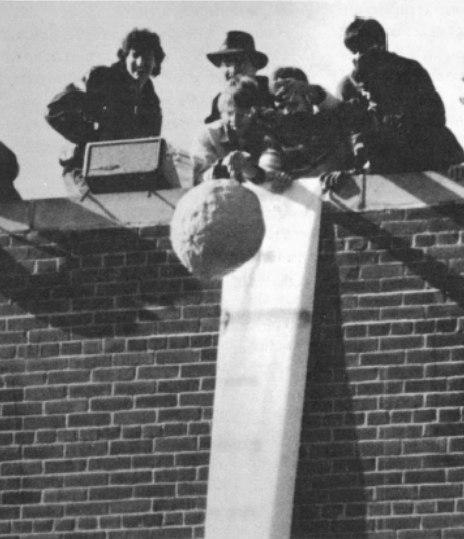Hands-on science: Engineering student’s 1989 experiment from McMahon rooftop draws a crowd

Nearly 35 years ago, Alfred University’s McMahon Engineering Building was the site of a public experiment that drew an audience of about 150 University staff, faculty and students.
The 1989 experiment was a stress test of sorts on a 100-pound polymer ball dropped from the roof of the northwest wing of McMahon, a fall of about thirty-seven feet. In smaller sizes, the polymer was known to bounce by 80 percent of its original drop height. Children were familiar with this bouncing capacity. The polymer went by the brand name of Silly Putty.
According to news reports in The Fiat Lux, the 100-pound ball was acquired from the then-Corning Glassworks by engineering graduate student John Wight Jr. The Glassworks, now Corning Inc., provided Silly Putty in 50-pound globs to institutions and organizations for educational and research purposes.
Theoretically, the ball should’ve bounced to a height of about thirty feet after hitting the pavement. Numerous onlookers, however, doubted that would happen. Some wore T-shirts emblazoned with “Splat, Shatter, or Bounce.” Those betting on the shatter scenario –numerous wagers reportedly had been placed – won the day. The ball hit the pavement, then broke into pieces as it bounced about seven feet into the air. Watch the video here.
The shattering effect was due to the principle of dilatancy, The Fiat Lux reported. Dilatancy describes how a 100-pound polymer blob may hit a hard surface with enough force to change its oozy physical property to brittle.
“When you drop something from such a height, things happen,” Wight explained recently from his home in Corning, NY, where he works for Corning Inc. as a senior research associate. “That mass of Silly Putty responded elastically, so we got some rebound. But the strain on the material exceeded its strength, so we got the fracturing.”
According to Wight, preparations for the experiment were extensive. Participants practiced dropping the Silly Putty inside McMahon, using the stairwell. Members of the Saxons football team were recruited to stand near the landing zone, in the event errant blobs of Silly Putty needed to be tackled.
A small orchestra was recruited to play music, and extra participants were on hand at the edge of the roof, just to make sure no student fell off as the 100-pound blob was released.
After Wight’s experiment, the smaller pieces of Silly Putty were distributed to onlookers who had paid $6.50 or $10 per pound. Early sponsors of the trial received the better deal.
Silly Putty was invented serendipitously in the 1940s, as scientists experimented with various materials in search of an alternative to rubber, which had become a rare commodity due to the Second World War. Credit for the invention is disputed: a scientist for Dow Corning named Earl Warrick may have been the first to mix boric acid with silicone oil; another scientist, James Wright, employed by General Electric, has also been credited. The controversy is unresolved. The branded material known as Silly Putty currently is sold by the parent company of Crayola.
Silly Putty was inducted into the National Toy Hall of Fame in 2001.
